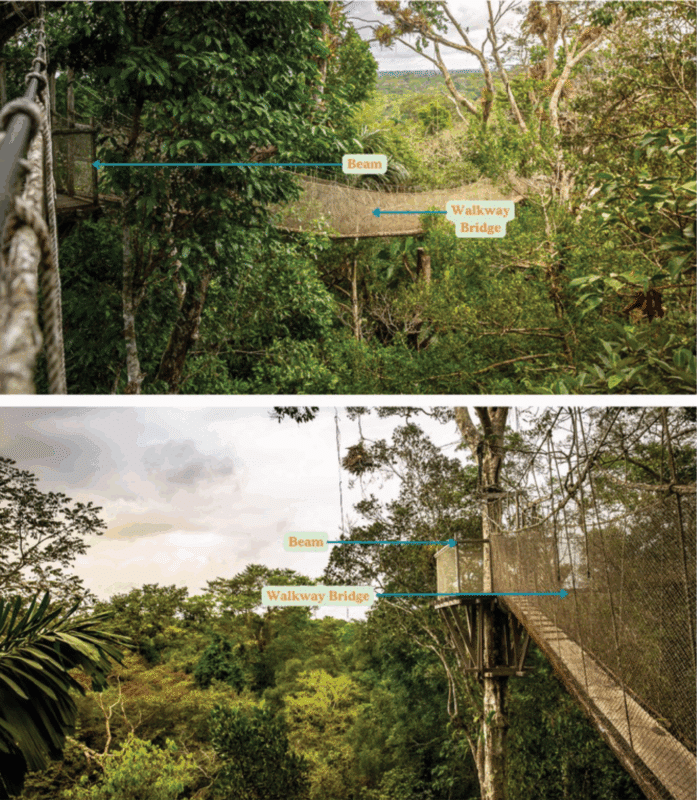In the dense expanse of the Amazon rainforest, wildlife often faces perilous challenges as they navigate fragmented habitats. However, a new study reveals a surprising twist: some species are using human-built infrastructure, like a canopy walkway, to move safely through the forest. Published in Neotropical Biology and Conservation, this research sheds light on how elevated bridges, originally constructed for tourists, are becoming crucial travel routes for arboreal animals. These unexpected pathways provide a rare look at the adaptability of Amazonian species amidst the ongoing threats of deforestation and habitat fragmentation.
The Hidden Highway Above the Amazon: An Unexpected Safe Route for Wildlife
Imagine an Amazonian sloth navigating an elevated bridge 80 feet above the forest floor, or a porcupine gliding through the trees with ease. This scenario, which might seem unlikely, is unfolding daily on the Amazon Conservatory for Tropical Studies’ (ACTS) canopy walkway near Iquitos, Peru. The structure, designed for human visitors to observe the rich biodiversity of the rainforest, has become an unintentional lifeline for a variety of mammal species.
Using advanced camera traps, researchers captured footage over a span of three weeks to track the nighttime movements of arboreal animals. The findings were both surprising and revealing. Species such as two-toed sloths, long-tailed porcupines, woolly opossums, and even a saki monkey were documented using the suspended platforms as a safe route through the fragmented forest. These animals, which typically avoid the forest floor due to its dangers, are now taking advantage of these human-made bridges, treating them as natural highways for nighttime travel.
The research, published in Neotropical Biology and Conservation, underscores the vital role that these elevated structures could play in protecting wildlife in increasingly fragmented ecosystems. The fact that these species are utilizing human infrastructure highlights how ecological challenges can sometimes lead to surprising solutions.

Canopy Walkways: A Bridge Between Fragmented Forests
As deforestation and human development continue to slice through the Amazon, the forest becomes more fragmented, leaving isolated patches of habitat that are harder for wildlife to navigate. For tree-dependent mammals, crossing between these patches can be a deadly endeavor. Roads, clearings, and other disruptions create dangerous barriers, particularly for species that spend the majority of their lives in the canopy.
In this context, the use of elevated bridges like the ACTS canopy walkway becomes not just a curiosity but a critical survival strategy. The structure connects treetops, allowing animals to bypass the risks of ground-level crossings. The cameras revealed that most crossings occurred between 7:00 and 9:00 p.m., just after sunset, during a period when many nocturnal species are most active. The findings suggest that the elevated paths offer both a temporal and physical refuge from the dangers lurking on the forest floor.
Importantly, the study points out that the middle levels of the canopy are particularly well-used, with animal traffic peaking at heights of 70 to 90 feet. This observation is valuable for conservation efforts, as it suggests that bridges designed to connect canopy trees at similar heights are more likely to be utilized by wildlife. In fact, previous studies have shown that crossing rates on canopy bridges can be significantly higher than on the ground below, emphasizing the importance of elevating wildlife passageways to ensure their effectiveness.
A Delicate Balance: Designing Effective Wildlife Bridges
The success of the ACTS canopy walkway as a safe passage for wildlife offers critical lessons for future bridge designs. It’s not just about building a structure but ensuring it connects the right habitat fragments and is at the correct height for animals to use it. The research highlights the significance of adding multiple connections and ensuring sufficient foliage cover to make these bridges more inviting for wildlife.
Moreover, the study’s findings underscore the importance of considering local microclimates when designing such bridges. Higher levels of the canopy were found to have warmer and slightly windier air, whereas the lower levels were cooler and more humid. These subtle environmental differences influence animal behavior, helping researchers fine-tune bridge placements to optimize usage. By integrating these factors into bridge designs, conservationists can increase the chances of success for similar projects in the future.

